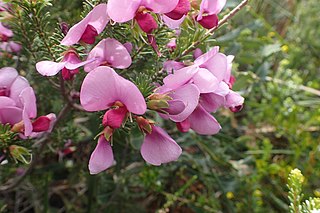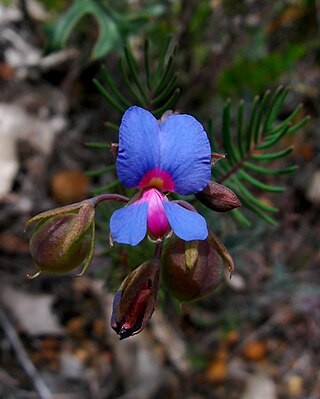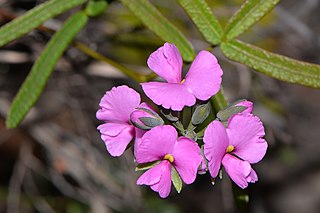
Gompholobium scabrum is a species of flowering plant in the pea family Fabaceae and is endemic to the south-west of Western Australia. It is an erect to spreading shrub with linear leaves and pink or purple flowers with some darker markings.

Gompholobium capitatum, commonly known as yellow pea, is a species of flowering plant in the family Fabaceae and is endemic to the south-west of Western Australia. It a slender, erect or ascending shrub with pinnate leaves and yellow flowers.

Gompholobium cyaninum is a species of flowering plant in the family Fabaceae and is endemic to the south-west of Western Australia. It is an erect to straggling shrub with pinnate leaves and blue, purple and red, pea-like flowers.
Gompholobium glutinosum is a species of flowering plant in the family Fabaceae and is endemic to the far west of Western Australia. It is an erect, openly-branched shrub with pinnate leaves with three to five leaflets, and yellow and red, pea-like flowers.
Gompholobium gompholobioides is a species of flowering plant in the family Fabaceae and is endemic to the south-west of Western Australia. It is a spreading shrub with pinnate leaves and uniformly yellow, pea-like flowers.
Gompholobium karijini is a species of flowering plant in the family Fabaceae and is endemic to the north-west of Western Australia. It is an erect, openly-branched shrub with pinnate leaves with five to ten pairs of leaflets, and racemes of yellow to orange and creamy-yellow, pea-like flowers.

Gompholobium knightianum is a species of flowering plant in the family Fabaceae and is endemic to the south-west of Western Australia. It is a slender, erect shrub with pinnate leaves, and mostly pink or purple, pea-like flowers.
Gompholobium laxum is a species of flowering plant in the family Fabaceae and is endemic to the south-west of Western Australia. It is an erect, open shrub with needle-shaped leaves and uniformly yellow, pea-like flowers.
Gompholobium oreophilum is a species of flowering plant in the family Fabaceae and is endemic to the north-west of Western Australia. It is an erect shrub with pinnate leaves with elliptic leaflets, and racemes of yellow to orange and creamy-yellow, pea-like flowers.
Gompholobium polyzygum is a species of flowering plant in the family Fabaceae and is endemic to north-western Australia. It is an erect or prostrate shrub with pinnate leaves each with sixteen to twenty-one pairs of leaflets, and yellow-orange and greenish, pea-like flowers.

Gompholobium preissii is a species of flowering plant in the family Fabaceae and is endemic to the south-west of Western Australia. It is an erect shrub with pinnate leaves with five to fifteen leaflets, and yellow, red and orange, pea-like flowers.
Gompholobium pungens is a species of flowering plant in the family Fabaceae and is endemic to the south-west of Western Australia. It is an erect, openly-branched shrub with spiny stems, pinnate leaves and mostly yellow, pea-like flowers with pink or purple markings.
Gompholobium roseum is a species of flowering plant in the family Fabaceae and is endemic to the south-west of Western Australia. It is an erect shrub with pinnate leaves and yellow, pink or green, pea-like flowers with pink or green markings.

Gompholobium shuttleworthii is a species of flowering plant in the pea family Fabaceae and is endemic to the south-west of Western Australia. It is an erect shrub with pinnate leaves with five to nine leaflets, and pink or purple flowers with some darker markings.
Gompholobium simplicifolium is a species of flowering plant in the pea family Fabaceae and is endemic arid part of Western Australia and the Northern Territory. It is an erect or spreading shrub with cylindrical leaves and orange-yellow, pea-like flowers.
Gompholobium subulatum is a species of flowering plant in the pea family Fabaceae and is endemic to northern Australia. It is a slender, erect shrub with pinnate leaves with five to eleven leaflets, and uniformly yellow, pea-like flowers.

Gompholobium venustum, commonly known as handsome wedge-pea, is a species of flowering plant in the family Fabaceae and is endemic to the south-west of Western Australia. It is a slender, erect or sprawling shrub with pinnate leaves with fifteen to nineteen leaflets, and yellow or pink, pea-like flowers.

Gompholobium villosum is a species of flowering plant in the pea family Fabaceae and is endemic to the south-west of Western Australia. It is a slender, erect shrub with simple, needle-shaped leaves with one or two grooves on the lower surface, and violet, pink or purple flowers.
Gompholobium viscidulum is a species of flowering plant in the pea family Fabaceae and is endemic to the south-west of Western Australia. It is an erect shrub with pinnate leaves with five to seven leaflets, and yellow flowers.
Gompholobium wonganense is a species of flowering plant in the family Fabaceae and is endemic to the Wongan Hills area of Western Australia. It is an erect, spreading shrub with simple leaves and uniformly yellow, pea-like flowers.








